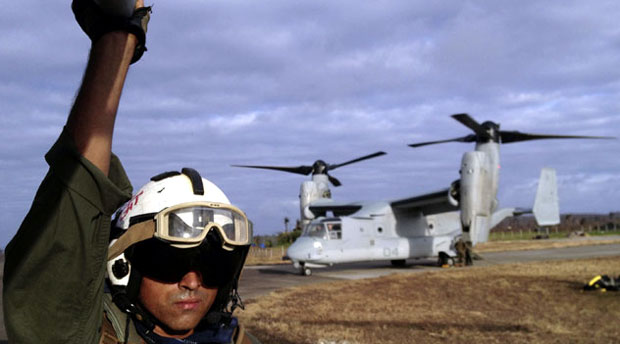US forces start pullout from typhoon-hit areas in Eastern Samar
GUIUAN, Philippines — Now that the Philippine military is able to distribute relief goods in all typhoon-affected towns in Eastern Samar, American forces in this town have started to pull out.
Colonel Wilson Leyba, commander of Task Force Guiuan, said US personnel started moving out on Thursday.
“Minimal na lang yung utilization ng air assets nila (There’s minimal use of their air assets now),” he told Inquirer.net at Guiuan airport.
“When our trucks from Manila arrived, we took over all relief operations, except for some islands (which are served by the US, by request),” Leyba said.
With roads blocked in the islands of Samar and Leyte during the first few days after the onslaught of supertyphoon “Yolanda,” US helicopters and planes were used to bring relief goods to isolated areas.
Article continues after this advertisementLogistics officer John Duenas of the US Navy’s Expeditionary Strike Group 7 said they are now “re-consolidating.”
Article continues after this advertisement“As the local government and the government of the Philippines are able to control the area on their own, we’re pulling back and letting the Philippines self-sustain,” he said.
On Thursday, the aircraft carrier USS George Washington, the first to respond to the devastation of “Yolanda” headed out of the country.

In this Nov. 19, 2013 photo, Lance Cpl. Michael Marin, 27, crew chief of a U.S. Marine MV-22 Osprey aircraft, waits to get refueled in Guiuan, Philippines to be able to fly back to Villamor Air Base in Manila after a humanitarian assistance mission to the areas affected by Typhoon Haiyan. AP FILE PHOTO
Duenas said they’ve been working side by side with Philippine authorities.
“Ultimately, we are just here to support and provide what assistance is necessary. The direction comes from the Philippine military,” he said.
US used helicopters and planes to reach far-flung areas such as the island villages of Guiuan.
“The V22 Ospreys – tilt rotors. Those have been critical to supporting this area. All it needs is a small patch of clearing. They can drop down, deliver the supplies, come back and reload,” he said.
In the airports of Guiuan, Tacloban and Cebu, they were able to deploy C-130 cargo planes to deliver relief goods.
Duenas said they were glad to assist the Philippines, which is a long-time ally of the US.
“We will certainly keep an eye on the areas that have been identified. Even if we’re moving out of the area, we will still be in the region,” he said.